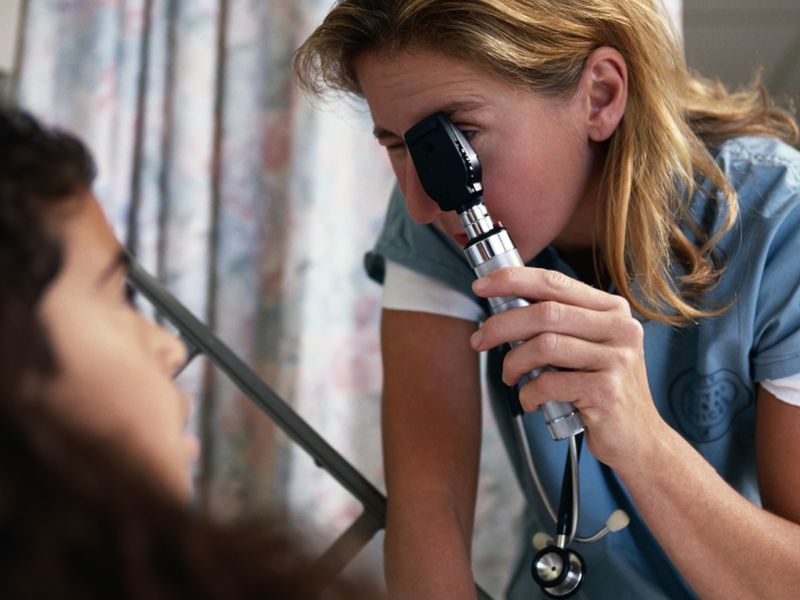
There is no cure for nearsightedness, but medicated eye drops can slow down its progression in children, a new trial finds.
The study tested the effects of eye drops containing a very low dose of the drug atropine — the same medication used to dilate the pupils during an eye exam.
Researchers found that when children with nearsightedness used the drops every day for three years, their vision worsened more slowly — and was more likely to stabilize — versus kids given placebo drops.
That does not mean the drops will reverse vision problems or liberate kids from glasses, experts stressed.
“The real point here is the longer term,” said lead researcher Karla Zadnik, dean of Ohio State University’s College of Optometry, in Columbus.
Nearsightedness, she explained, arises when at some point during childhood, the eyeball “grows too long” and becomes more oval-shaped than round. That alters how light hits the retina, the light-sensitive tissue at the back of the eye — turning far vision into a “big, blurry mess,” Zadnik explained.
Glasses or contact lenses can clear up that mess, but the underlying nearsightedness typically keeps progressing until at least the mid-teens.
That matters, Zadnik said, because more severe nearsightedness can lead to problems for some people in adulthood. That elongated eyeball can raise the risk of conditions like retinal detachment, glaucoma and cataracts.
Whether atropine eye drops can ultimately help prevent those conditions is unknown, Zadnik said, since that would take a very long study.
“All we can say is what happens at three years,” she said.
Atropine is a drug with many uses, including in diagnosing and treating various eye conditions. Most people are probably familiar with the atropine drops used to dilate the pupils during routine eye exams.
The dose used for kids’ nearsightedness is much lower, Zadnik said. It’s thought to work by slowing down the elongation of the eyeball.
The new study, published online June 1 in JAMA Ophthalmology, is not the first to show that low-dose atropine may slow kids’ nearsightedness progression. Several smaller, shorter-term trials have suggested as much.
In fact, eye doctors already commonly prescribe low-dose atropine “off-label” for managing kids’ nearsightedness, Zadnik said.
But, Zadnik added, those low-dose formulations are typically made by compounding pharmacies, and may contain preservatives that can cause side effects like dry eye or corneal irritation.
The product used in this trial is being developed by Vyluma Inc., which late last year said it planned to seek approval from the U.S. Food and Drug Administration.
For the study, Zadnik’s team recruited 576 nearsighted kids who were 9 years old, on average. They randomly assigned 411 to use either of two doses of atropine eye drops, and 165 to use placebo drops.
After three years, 28.5% of children on the lower atropine dose — 0.01% atropine — were considered to be “responders.” That meant they had minimal change in their vision: Basically, Zadnik said, they didn’t need a prescription change.
By comparison, the response rate in the placebo group was 17%. Of kids on the higher atropine dose (0.02%), 22% were responders — which was not different, in statistical terms, from the placebo group.
Zadnik said that children who were not full responders still stood to see benefits. Nearsightedness progression was slower, on average, among kids on 0.01% atropine, versus the placebo.
The findings leave some questions open: When can kids stop using atropine drops, and what happens once they do?
“Right now, we have no data to guide us on when to stop,” said Dr. Rudrani Banik, an ophthalmologist with the New York Eye and Ear Infirmary of Mount Sinai, in New York City.
So, she said, eye doctors who prescribe the drops off-label generally rely on monitoring kids’ vision. If there’s nearsightedness progression after a child stops using atropine, they’ll typically recommend starting again.
Banik, who was not involved in the trial, said it supports low-dose atropine drops as an option.
“It’s relatively straightforward — just one dose at bedtime,” she said. But, Banik added, some kids do have side effects, like light sensitivity or itchy, watery eyes.
There’s also cost. The current compounded formulations can range from $55 to over $100 a month, Banik said, and they are generally not covered by insurance.
If the Vyluma product is approved, it’s not clear what it will cost — but, Banik noted, insurers might cover it.
She also pointed to another potential tactic: time outdoors. Studies suggest that kids who spend more time outside have a slower progression in nearsightedness. Whether that’s due to the natural light, less time on devices or some combination of factors is not known.
“But outdoor time is great for kids for many reasons,” Banik said. “So parents can consider whether their child is getting enough.”
More information
The American Academy of Pediatrics has more on nearsightedness.
SOURCES: Karla Zadnik, OD, PhD, professor, optometry and physiological optics, dean, School of Optometry, Ohio State University, Columbus; Rudrani Banik, MD, ophthalmologist, New York Eye and Ear Infirmary of Mount Sinai, and associate professor, ophthalmology, Icahn School of Medicine at Mount Sinai, New York City; JAMA Ophthalmology, June 1, 2023, online
Source: HealthDay
Copyright © 2024 HealthDay. All rights reserved.

Leave a Reply